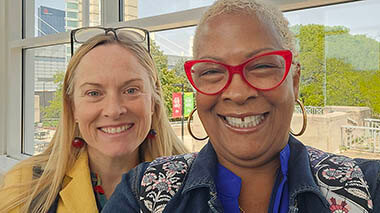Andrea Dell is a 37-year-old professional running coach who’s used to running marathons, in addition to working in IT, being a wife, and raising a daughter. As a child, she suffered from asthma — but she found doctors, medications, and strategies that allowed her to start running and stick with it. In other words, she’s one tough mama who doesn’t back down from a challenge. But a few years ago, a new, intense pain nearly stopped Andrea from doing the things she loved.
A long road to a proper diagnosis
“In October of 2018, I started having this tremendous pain in my side, just under my rib cage,” says Andrea. “It was debilitating. I was at a friend’s house one night and by the end of the evening I couldn’t even stand up or pick up my daughter.”
Thinking it was an issue from her training, Andrea saw a doctor who specialized in sports medicine. He told her what she was experiencing wasn’t muscular pain, and sent her back to her primary care doctor. Her nurse practitioner ordered a battery of tests, including an ultrasound of her gallbladder and liver.
“I had every test I could get,” says Andrea. “All of them came back normal, except I discovered I had ovarian cysts, and a couple of them were pretty large.” Her first doctor, who is not with Atrium Health, told Andrea that the cysts were responsible for her pain, and that they’d probably burst and then her pain would be resolved.
In early 2019, Andrea ran several half-marathons and marathons — but a few months into the year, she found her pain increasing with each long-distance run she did.
“The pain got worse and lasted longer. It was like the entire right side of my body shut down, like someone had a vice grip on my rib cage, diaphragm, and liver and was twisting it. I couldn’t breathe deeply at all,” she says.
Andrea began to question why an ovarian cyst would cause rib pain. “Runners know their bodies,” says Andrea. “I knew something was wrong, but I couldn’t figure it out.” Then one day in March, Andrea experienced such intense pain that she couldn’t breathe. She headed to the emergency room, where she was given morphine for her pain and had a CT scan — but no definitive answer explained what could be the root cause of her pain.
A long road ahead
By that point, Andrea was in pain for roughly twenty days out of the month. Doing her own research led her to believe she had endometriosis. She consulted with another doctor outside of Atrium Health and “I begged the doctor to perform surgery on me,” Andrea says. The doctor performed surgery to remove some of Andrea’s cysts, but neglected to remove any of the endometriosis or do a full abdominal survey or biopsy.
The doctor also wanted to put Andrea on a medication, called Lupron, that could lead to bone loss as an adverse side effect. “As an endurance athlete, this was not acceptable to me. The one thing that gives me purpose is running,” says Andrea.
She asked her doctor about other treatment options, but was told there were none. Andrea did more research on her own and eventually found Smitha Vilasagar, MD, FACOG a minimally-invasive gynecologic surgeon with Atrium Health Women’s Center for Pelvic Health.
What is endometriosis?
Endometriosis occurs when tissue similar to the uterine lining grows outside of the uterus. This can lead to issues such as intense pain, inflammation, and scarring (and in some cases, infertility). Endometriosis affects up to 10% of women. It is commonly found in the pelvis and abdomen, but can also be found in other locations, including the diaphragm or lungs. The condition can range from moderate to severe.
Endometriosis can be difficult to properly diagnose, since the diagnosis is first suspected based on symptoms of painful periods and pelvic pain. There are no blood tests or imaging studies that can diagnosis endometriosis. Definitive diagnosis requires surgery with excision of the lesions, which must be sent to pathology for confirmation.
A new course of action finally leads to real results
Andrea describes her initial consult with Dr. Vilasagar as life-changing. “I had suffered for so long, and I had so much hope once I saw Dr. Vilasagar,” says Andrea, “She said there are few cases like the one I had, but together we would figure it out.”
“When I first saw Andrea, I could tell she was really suffering in pain and clearly was experiencing a dramatic change in her quality of her life,” says Dr. Vilasagar. “She just knew something was wrong with her body and needed answers.”
After talking to Andrea, Dr. Vilasagar suspected that Andrea had endometriosis, and possibly even on her diaphragm given her type of pain.
Dr. Vilasagar recommended physical therapy (PT) followed by surgery. “PT was a way to help relax, stretch, and lengthen the muscles that had become very tense and tender in response to her being in pain,” explains Dr. Vilasagar.
Andrea’s surgery confirmed Dr. Vilasagar’s suspicions about the extent of her endometriosis. Dr Vilasagar performed a total laparoscopic hysterectomy and laparoscopic excision of endometriosis on Andrea. “Andrea's surgery was complex because I had to excise endometriosis disease extending from her diaphragm to her pelvis, even on her bladder and bowel,” says Dr. Vilasagar.
“Unfortunately, many women with endometriosis end up having multiple surgeries because the most optimal surgery, which is excision of endometriosis, isn't widely performed,” reports Dr. Vilasagar “Patients travel from all over the country, and even from other countries, to seek this type of surgery and the highest level of care here at Atrium Health.”
Post-surgery: back to running, this time without pain
Andrea's recovery was swift, and she responded well to surgery. “When I saw Andrea after her surgery, it was like night and day. She had her life back and was pain-free, happy, and brighter,” says Dr. Vilasagar.
“Within days, my movement patterns were different,” Andrea concurs. “The pain in my hip was reduced. I could sit, I could lay comfortably. I knew within a week that things were different.” Only four weeks after surgery at Andrea’s post-op appointment, Dr. Vilasagar gave Andrea the go-ahead to run a Disney Princess 5K with her daughter. “And the day after the 5K, we went and ran a 10K,” adds Andrea.
Now, Andrea is back to running marathons and feeling great. “For every person who might have symptoms of endometriosis, I would urge them to keep going until they get a proper diagnosis and treatment options,” Andrea advises. “I had to see a sports doctor, nurse practitioner, OB/GYN, ER, orthopedist doctors, and I also had an MRI, CT scan, and surgery before I figured it out.”
Dr. Vilasagar agrees, saying “Women have great insight into their bodies. Pain can be scary and is often a sign that something could be off. I urge all women to listen to their own bodies and advocate for themselves to find the proper care. With all of my patients, I prioritize understanding their symptoms and history, as well as their goals of therapy, which is different for every woman.” For women who may want to have children, it is important to try to seek care early on in efforts to preserve fertility and reduce long-term pain.
She adds, “We all need to talk openly about the symptoms of pelvic pain and endometriosis to change the dialogue around this condition. I love being in a position to empower women, to help them trust and understand their bodies, and get their lives back. Finally receiving the diagnosis is incredibly validating for my patients who often suffer for years. After the right type of surgery for this condition, the differences in quality of life for my patients is profound, which is incredibly rewarding,” says Dr. Vilasagar.
Read more about endometriosis pain



